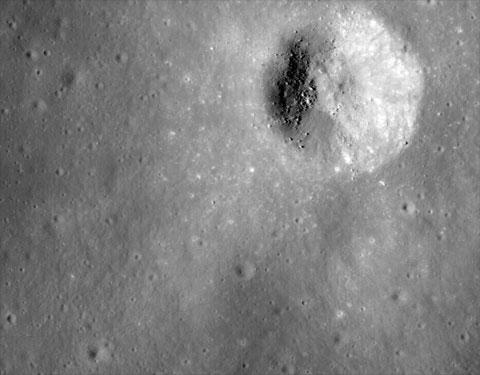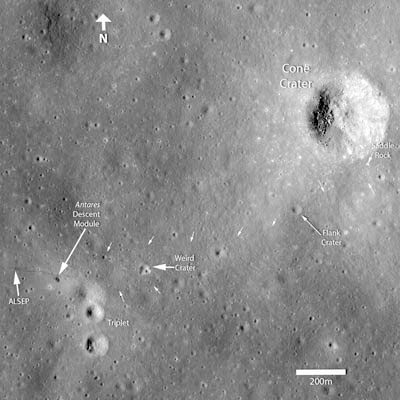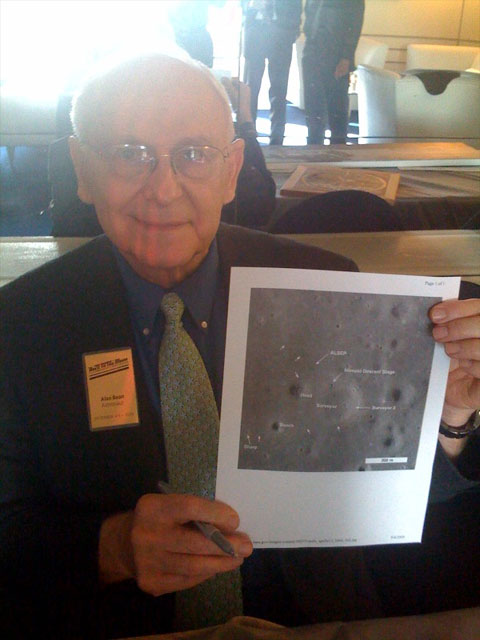|
Author
|
Topic: [Discuss] Lunar Reconnaissance Orbiter
|
gliderpilotuk
Member Posts: 3415
From: London, UK
Registered: Feb 2002
|
 posted 07-19-2009 01:50 PM
posted 07-19-2009 01:50 PM
   
I'm surprised at the length of the Apollo 11 LEM shadow. The descent stage was 3.2 metres high, but the shadow appears to be about 15 metres. Guess the Sun was very low! |
liftoff
Member Posts: 47
From: Watt, Switzerland
Registered: Jun 2008
|
 posted 07-20-2009 02:36 AM
posted 07-20-2009 02:36 AM
   
Wonderful pictures! When Apollo 11 landed, I was only four years old. Unfortunately, I have no memory of it. These fantastic images, therefore, give me the possibility to experience the historic moment of the first Apollo mission 40 years later.Congratulations to the team of the LRO mission for their great work! |
burnsnz
Member Posts: 81
From: Auckland, New Zealand
Registered: Jan 2004
|
 posted 07-20-2009 02:29 PM
posted 07-20-2009 02:29 PM
   
Pretty cool in the Apollo 11 image that you can see the narrow shadow of the Descent Engine Bell close to the landing site, then the wider shadow of the octagonal Descent stage further to the right. Regarding shadow length, you always get higher contrast images with low sun angles. I am pretty sure that all the landings occurred close to the local lunar dawn because of this as well. |
ilbasso
Member Posts: 1527
From: Greensboro, NC USA
Registered: Feb 2006
|
 posted 07-20-2009 08:52 PM
posted 07-20-2009 08:52 PM
   
quote:
Originally posted by gliderpilotuk:
I'm surprised at the length of the Apollo 11 LEM shadow. The descent stage was 3.2 metres high, but the shadow appears to be about 15 metres. Guess the Sun was very low!
Yes, check out the length of YOUR shadow at sunset sometime!The low sun angles provide shadows which accentuate the unevenness of the terrain. Look at pics of the full moon, when the sun is overhead. You can't tell anything about the high or low spots or the depth of craters. At low sun angles close to sunrise and sunset, all the details pop out. That's why we landed so close to sunrise. We didn't land close to sunset, because if something happened to delay the landing (like on Apollo 16) the landing site would be in darkness once night fell. |
Jurg Bolli
Member Posts: 1185
From: Albuquerque, NM
Registered: Nov 2000
|
 posted 07-21-2009 03:11 PM
posted 07-21-2009 03:11 PM
   
Fabulous images, it makes me feel as if I am there on the moon. |
mark plas
Member Posts: 385
From: the Netherlands
Registered: Aug 2000
|
 posted 07-26-2009 04:47 AM
posted 07-26-2009 04:47 AM
   
Is that the S-band antenna next to Antares on the image of the Apollo 14 site? |
Paul Littler
Member Posts: 70
From: Brentwood, Essex, UK
Registered: Jul 2003
|
 posted 08-13-2009 05:33 PM
posted 08-13-2009 05:33 PM
   
Can someone advise when LRO will leave the commissioning orbit and get into the lower working orbit? |
Robert Pearlman
Editor Posts: 50476
From: Houston, TX
Registered: Nov 1999
|
 posted 08-13-2009 06:01 PM
posted 08-13-2009 06:01 PM
   
I don't have the exact date of it entering the mapping orbit (yet) but a news conference has been scheduled for August 27 to discuss "First Light" for LRO. |
Scott
Member Posts: 3337
From: Houston, TX
Registered: May 2001
|
 posted 08-20-2009 07:46 AM
posted 08-20-2009 07:46 AM
   
New LRO image of the Apollo 14 landing site which includes Cone Crater (the bright crater halfway down, near the right edge of the image). |
Michael Davis
Member Posts: 559
From: Houston, Texas
Registered: Aug 2002
|
 posted 08-20-2009 08:49 AM
posted 08-20-2009 08:49 AM
   
Is there any definitive answer from this new image of Cone crater as to just how close Shepard and Mitchell got to the edge? Their trail seems to get too faint for me to see amide the jumble near the summit. |
mmmoo
Member Posts: 577
From: London, England
Registered: May 2001
|
 posted 08-20-2009 09:30 AM
posted 08-20-2009 09:30 AM
   
Here is a cropped view of Cone Crater. You can just make out the trail of the astronauts to the bottom left. The trail seems to stop just close to a much smaller crater, below and left of Cone Crater. |
spaced out
Member Posts: 3190
From: Paris, France
Registered: Aug 2003
|
 posted 08-20-2009 09:59 AM
posted 08-20-2009 09:59 AM
   
quote:
Originally posted by Michael Davis:
Is there any definitive answer from this new image of Cone crater as to just how close Shepard and Mitchell got to the edge?
The visible trail matches the traverse worked-out post-flight as shown on the Apollo 14 page of the Apollo Lunar Surface Journal.I believe Saddle Rock was the closest they came, and this is clearly visible in the image. |
4allmankind
Member Posts: 1092
From: Dallas
Registered: Jan 2004
|
 posted 08-20-2009 01:22 PM
posted 08-20-2009 01:22 PM
   
That image is absolutely unbelievable. Amazing detail... I am stunned.I am sure Ed Mitchell would love a view of it as well.  |
spaced out
Member Posts: 3190
From: Paris, France
Registered: Aug 2003
|
 posted 08-20-2009 01:44 PM
posted 08-20-2009 01:44 PM
   
As the spacecraft makes other passes over the landing sites at different times of the lunar 'day' different sections of the various tracks on the surface will show up more or less clearly as the sun strikes the irregular lunar surface at various angles.Some parts of the Apollo 14 trails that don't show up too clearly on this shot will be more visible in later images. |
AstroAutos
Member Posts: 803
From: Co. Monaghan, Republic of Ireland
Registered: Mar 2009
|
 posted 08-20-2009 02:20 PM
posted 08-20-2009 02:20 PM
   
What an amzing photo.This Lunar Reconnaissance Orbiter certainly is doing it's job.. thanks for adding all these brilliant images guys! |
Dave Clow
Member Posts: 236
From: South Pasadena, CA 91030
Registered: Nov 2003
|
 posted 08-20-2009 03:38 PM
posted 08-20-2009 03:38 PM
   
Utterly amazing. |
tegwilym
Member Posts: 2339
From: Sturgeon Bay, WI
Registered: Jan 2000
|
 posted 08-21-2009 04:47 PM
posted 08-21-2009 04:47 PM
   
quote:
Originally posted by 4allmankind:
I am sure Ed Mitchell would love a view of it as well.
I want a copy of this photo signed by Ed! Now THAT would be cool.  When was the LRO going to be at it's final and lowest orbit? I thought it was sometime in October, but forget. These are just going to get better over time. Very, very, cool stuff! |
Robert Pearlman
Editor Posts: 50476
From: Houston, TX
Registered: Nov 1999
|
 posted 08-21-2009 04:57 PM
posted 08-21-2009 04:57 PM
   
quote:
Originally posted by tegwilym:
When was the LRO going to be at it's final and lowest orbit?
At the end of August; there is a news conference set to discuss its first mapping image on August 27. |
Paul Littler
Member Posts: 70
From: Brentwood, Essex, UK
Registered: Jul 2003
|
 posted 08-22-2009 06:43 AM
posted 08-22-2009 06:43 AM
   
I am sure we all have a few friends who "wind us up" about the moon landings.I will enjoy showing my friends these photos but NASA said they would not waste a penny on proving the landings happened and this is not really what these photos are about. As the landing sites are the areas of the moon NASA knows more about than others am I not correct in believing that NASA want to find out if there are any "recent" craters that have arrived since the astronauts left? Then armed with that information NASA can calculate the risks of any bases or long term mission being hit. Has there been any work along these lines yet or is it too soon to say? |
Robert Pearlman
Editor Posts: 50476
From: Houston, TX
Registered: Nov 1999
|
 posted 08-22-2009 07:26 AM
posted 08-22-2009 07:26 AM
   
Impact rates are among the studies that will come from the Lunar Reconnaissance Orbiter data, but there is a much easier explanation for why NASA is imaging the landing sites: namely, the goal of the mission is to map as much of the Moon as possible, Apollo landing sites included.We currently have better maps of Mars than we do of the Moon. LRO is intended to correct that situation by providing an on-par surface guide to our nearest neighbor. |
AstroAutos
Member Posts: 803
From: Co. Monaghan, Republic of Ireland
Registered: Mar 2009
|
 posted 08-22-2009 04:23 PM
posted 08-22-2009 04:23 PM
   
quote:
Originally posted by tegwilym:
I want a copy of this photo signed by Ed!
I agree, that would be cool. I think a nice inscription would be "Fra Mauro Base - The place I called home for a day..." |
cjh5801
Member Posts: 189
From: Lacey
Registered: Jun 2009
|
 posted 08-22-2009 05:35 PM
posted 08-22-2009 05:35 PM
   
How about "Missed it by that much." |
Blackarrow
Member Posts: 3602
From: Belfast, United Kingdom
Registered: Feb 2002
|
 posted 08-23-2009 03:21 PM
posted 08-23-2009 03:21 PM
  
The LRO camera imagery clearly shows that that the astronauts just barely missed the rim of Cone crater by less than 100 feet. I remember reading in a 1971 news report (which I can't now find) that when the astronauts' photographs had been examined, and it became clear how close they had come to the edge of Cone Crater, someone in NASA told Shepard and Mitchell: "You weren't lost but you didn't know it!" |
Pat Gleeson
Member Posts: 44
From: Limerick, Ireland
Registered: Aug 2009
|
 posted 08-26-2009 03:11 PM
posted 08-26-2009 03:11 PM
   
quote:
Originally posted by 4allmankind:
I am sure Ed Mitchell would love a view of it as well.
Amazing indeed. I think Ed Mitchell would look at with some frustration also - man how close they were!  Reading Andy Chaikin's 'Man on The Moon' gives you a great idea of how close they were too. This confirms just how close. |
DChudwin
Member Posts: 1121
From: Lincolnshire IL USA
Registered: Aug 2000
|
 posted 08-29-2009 09:22 PM
posted 08-29-2009 09:22 PM
   
Some of the early Lunar Reconnaissance Orbiter Camera (LROC) pictures are now available on this website -- there are some amazingly detailed views of the Moon. |
ilbasso
Member Posts: 1527
From: Greensboro, NC USA
Registered: Feb 2006
|
 posted 08-29-2009 10:34 PM
posted 08-29-2009 10:34 PM
   
The Lunar Orbiter Imagery Recovery Project (LOIRP) has posted an excellent side-by-side comparison of the Apollo 14 landing site photos from Lunar Orbiter III (1967) and LROC. It's easy to see the effects of Apollo 14 on the landscape. |
Philip
Member Posts: 6217
From: Brussels, Belgium
Registered: Jan 2001
|
 posted 09-01-2009 11:16 AM
posted 09-01-2009 11:16 AM
   
The most amazing thing for me is the fact that the wheelbarrow Apollo 14 astronauts used, made such good tracks... |
jimsz
Member Posts: 644
From:
Registered: Aug 2006
|
 posted 09-03-2009 12:54 PM
posted 09-03-2009 12:54 PM
   
Has the orbiter dropped to it's permanent lower orbit yet? |
Scott
Member Posts: 3337
From: Houston, TX
Registered: May 2001
|
 posted 09-03-2009 04:00 PM
posted 09-03-2009 04:00 PM
   
Not yet — I believe that will happen in mid-September. |
ilbasso
Member Posts: 1527
From: Greensboro, NC USA
Registered: Feb 2006
|
 posted 09-03-2009 09:16 PM
posted 09-03-2009 09:16 PM
   
I wish Pete Conrad were here to see those pictures. I wonder what he'd have to say? |
tegwilym
Member Posts: 2339
From: Sturgeon Bay, WI
Registered: Jan 2000
|
 posted 09-04-2009 02:20 PM
posted 09-04-2009 02:20 PM
   
"Whoooopie!" |
DChudwin
Member Posts: 1121
From: Lincolnshire IL USA
Registered: Aug 2000
|
 posted 09-04-2009 06:48 PM
posted 09-04-2009 06:48 PM
   
It is amazing how well 40 years later you can see the tracks of Conrad and Bean on the surface, including some near Surveyor. Footprints last a long time when there is no wind or atmosphere. |
cjh5801
Member Posts: 189
From: Lacey
Registered: Jun 2009
|
 posted 09-05-2009 04:54 PM
posted 09-05-2009 04:54 PM
   
If it's any consolation to Alan Bean, the above photo makes it clear that much of the crew's activities on the lunar surface would have been out of the stationary TV camera's range anyway. |
FFrench
Member Posts: 3288
From: San Diego
Registered: Feb 2002
|
 posted 09-05-2009 06:56 PM
posted 09-05-2009 06:56 PM
  
quote:
Originally posted by ilbasso:
I wish Pete Conrad were here to see those pictures. I wonder what he'd have to say?
I had a very nice opportunity to talk to Al Bean about the image the day after it was released, as he is here at the museum... he seems to have just as much of a sense of wonder as anyone to see his own footprints still there forty years later. It's a powerful image. |
Blackarrow
Member Posts: 3602
From: Belfast, United Kingdom
Registered: Feb 2002
|
 posted 09-06-2009 12:22 PM
posted 09-06-2009 12:22 PM
  
Hmmm, seems like you pointed your camera a bit too close to the sun, there, Francis! |
FFrench
Member Posts: 3288
From: San Diego
Registered: Feb 2002
|
 posted 09-08-2009 07:01 PM
posted 09-08-2009 07:01 PM
  
That always seems to happen when Al is around, doesn't it?!  |
DChudwin
Member Posts: 1121
From: Lincolnshire IL USA
Registered: Aug 2000
|
 posted 09-19-2009 08:26 AM
posted 09-19-2009 08:26 AM
   
According to the first measurements from the Diviner instrument, large areas in the permanently shadowed craters are about minus 400 degrees Fahrenheit (33 Kelvin), more than cold enough to store water ice or hydrogen for billions of years. This is amazing! What is in those craters is a "time capsule" of the development of the Moon. I knew it is cold in permanently shadowed areas, but I did not realize as low as 33 K. |
Philip
Member Posts: 6217
From: Brussels, Belgium
Registered: Jan 2001
|
 posted 09-20-2009 06:54 AM
posted 09-20-2009 06:54 AM
   
It would be interesting to see the resting places of unmanned Moon explorers of the 1960s on LRO images, such as Surveyor V. |
alanh_7
Member Posts: 1267
From: Ajax, Ontario, Canada
Registered: Apr 2008
|
 posted 10-08-2009 12:58 PM
posted 10-08-2009 12:58 PM
   
Has there been any thought in using the LRO to try and find and photograph the impact sites of the Lunar Module ascent stages or SIVB’s? It might be interesting to investigate. |
FFrench
Member Posts: 3288
From: San Diego
Registered: Feb 2002
|
 posted 11-02-2009 11:14 PM
posted 11-02-2009 11:14 PM
  
Can we tell from the shadow in this low-pixel (at high zoom) image whether the flag has survived at all, or whether (as many predicted) the fabric has disintegrated, leaving only the vertical and horizontal pole assembly? |
















